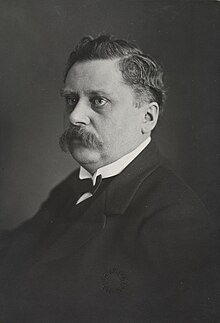Alfred Werner(12 December 1866 – 15 November 1919) was a Swisschemistwho was a student atETH Zurichand a professor at theUniversity of Zurich.He won theNobel Prize in Chemistryin 1913 for proposing theoctahedralconfiguration oftransition metalcomplexes. Werner developed the basis for moderncoordination chemistry.He was the firstinorganic chemistto win the Nobel Prize, and the only one prior to 1973.[2]
Alfred Werner | |
|---|---|
 Werner circa 1915 | |
| Born | 12 December 1866 |
| Died | 15 November 1919(aged 52) Zürich,Switzerland |
| Nationality | Swiss (from 1895) French |
| Alma mater | University of Zurich ETH Zurich |
| Known for | Configuration oftransition metalcomplexes |
| Spouse | Emma Werner[1] |
| Awards | Nobel Prize for Chemistry(1913) |
| Scientific career | |
| Fields | Inorganic chemistry |
| Institutions | University of Zurich |
| Doctoral advisor | Arthur Rudolf Hantzsch,Marcellin Berthelot[citation needed] |
Biography
editWerner was born in 1866 inMulhouse,Alsace(which was then part of France, but which was annexed by Germany in 1871). He was raised asRoman Catholic.[3]He was the fourth and last child of Jean-Adam Werner, a foundry worker, and his second wife, Salomé Jeannette Werner, who originated from a wealthy family.[3]He went to Switzerland to study chemistry at theSwiss Federal Institute (polytechnikum) in Zurich.Still, since this institute was not empowered to grant doctorates until 1909, Werner received a doctorate formally from the University of Zürich in 1890.[3]After postdoctoral study inParis,he returned to the Swiss Federal Institute to teach (1892). In 1893 he moved to theUniversity of Zurich,where he became a professor in 1895. In 1894 he became a Swiss citizen.[3]
In his last year, he suffered from a general, progressive, degenerativearteriosclerosis,especially of the brain, aggravated by years of excessive drinking and overwork. He died in a psychiatric hospital inZürich.[3]
Werner died on 15 November 1919 ofarteriosclerosisin Zürich at the age of 52.
Research
editCoordination chemistry
editIn 1893, Werner was the first to propose correct structures for coordination compounds containingcomplex ions,in which a central transition metal atom is surrounded by neutral or anionicligands.
For example, it was known that cobalt forms a "complex" hexamine cobalt (III) chloride, with formula CoCl3•6NH3,but the nature of the association indicated by the dot was mysterious. Werner proposed the structure[Co(NH3)6]Cl3,with the Co3+ion surrounded by six NH3at the vertices of an octahedron. The three Cl−are dissociated as free ions, which Werner confirmed by measuring theconductivityof the compound in an aqueous solution, and also by chloride anion analysis using precipitation withsilver nitrate.Later,magnetic susceptibilityanalysis was also used to confirm Werner's proposal for the chemical nature of CoCl3•6NH3.
For complexes with more than one type of ligand, Werner succeeded in explaining the number ofisomersobserved. For example, he explained the existence of two tetramine isomers, "Co(NH3)4Cl3",one green and one purple. Werner proposed that these are twogeometric isomersof formula [Co(NH3)4Cl2]Cl, with one Cl−ion dissociated as confirmed by conductivity measurements. The Co atom is surrounded by four NH3and two Cl ligands at the vertices of an octahedron. The green isomer is "trans" with the two Cl ligands at opposite vertices, and the purple is "cis" with the two Cl at adjacent vertices.
Werner also prepared complexes withoptical isomers,and in 1914 he reported the first syntheticchiralcompound lacking carbon, known ashexolwith formula [Co(Co(NH3)4(OH)2)3]Br6.
Nature of valence
editBefore Werner, chemists defined thevalenceof an element as the number of its bonds without distinguishing different types of bonds. However, in complexes such as [Co(NH3)6]Cl3for example, Werner considered that the Co-Cl bonds correspond to a "primary" valence of 3 at long distance, while the Co-NH3bonds which correspond to a "secondary" or weaker valence of 6 at shorter length. This secondary valence of 6 he referred to as thecoordination numberwhich he defined as the number of molecules (here of NH3) directly linked to the central metal atom. In other complexes, he found coordination numbers of 4 or 8.
On these views, and other similar views, in 1904Richard Abeggformulated what is now known asAbegg's rulewhich states that the difference between the maximum positive and negativevalenceof anelementis frequently eight. This rule was used later in 1916 whenGilbert N. Lewisformulated the "octet rule"in hiscubical atomtheory.
In modern terminology, Werner's primary valence corresponds to theoxidation state,and his secondary valence is calledcoordination number.The Co-Cl bonds (in the above example) are now classed as ionic, and each Co-N bond is acoordinate covalent bondbetween theLewis acidCo3+and theLewis baseNH3.
Works
edit- Lehrbuch der Stereochemie.Fischer, Jena 1904Digital editionby theUniversity and State Library Düsseldorf
References
edit- W. Gregory Jackson; Josephine A. McKeon; Silvia Cortez (2004). "Alfred Werner's Inorganic Counterparts of Racemic and Mesomeric Tartaric Acid: A Milestone Revisited".Inorg. Chem.43(20): 6249–6254.doi:10.1021/ic040042e.PMID15446870.
- Kristin Bowman-James(2005). "Alfred Werner Revisited: The Coordination Chemistry of Anions".Acc. Chem. Res.38(8): 671–678.doi:10.1021/ar040071t.PMID16104690.
- ^"Alfred Werner - Nobel Prize for Chemistry 1913"(PDF).University of Zurich.Retrieved9 December2022.
He moved there with his wife, Emma Wilhelmine, née Giesker, whom he had married on 1 October 1894.
- ^https://www.nobelprize.org/nobel_prizes/chemistry/laureates/1913/werner-bio.htmlNobel Prize Retrieved 1 December 2012
- ^abcde"Alfred Werner - Swiss chemist".britannica.com.Retrieved14 April2018.
External links
edit- Alfred Werneron Nobelprize.orgincluding the Nobel Lecture, 11 December 1913On the Constitution and Configuration of Higher-Order Compounds
- The Nobel Prize in Chemistry 1913- short article about his work on the linkage of atoms in molecules by which he has thrown new light on earlier investigations and opened up new fields of research, especially in inorganic chemistry.